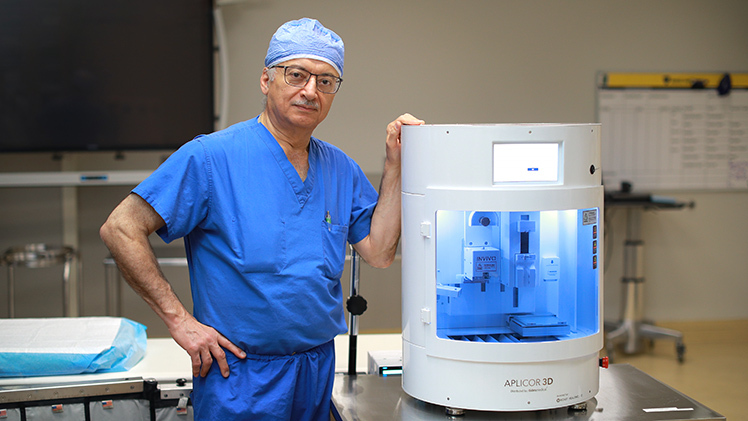UToledo Health is one of the first healthcare systems in the country to treat chronic wounds using 3D printed grafts derived from a patient’s own fat cells.
The technology, which has been approved in the U.S. marketplace for less than a year, has the potential to revolutionize care for individuals with non-healing wounds, said Dr. Munier Nazzal, a UToledo Health vascular surgeon.

Dr. Munier Nazzal, a UToledo Health vascular surgeon, poses with a 3D graft printer. UToledo Health is one of the first healthcare systems in the country to treat chronic wounds using 3D printed grafts derived from a patient’s own fat cells.
“Most wounds heal on their own. It may take some time or require minor surgery, but most cuts and abrasions are eventually going to heal,” said Nazzal, who is chief of the Division of Vascular, Endovascular Surgery and Wound Care at UTMC. “However, some wounds, particularly in patients with underlying medical conditions, fail to heal for months or even years. This technology is going to make a huge difference.”
The new procedure combines the latest bioprinting technology with the unique ability of a certain type of cells found in body fat to stimulate healing. The precision-medicine approach uses a graft made of a patient’s own cells to promote faster healing of chronic wounds.
Physicians start by using detailed photos and artificial intelligence to create a 3D model of the patient’s wound. A small amount of fat is then collected from the patient — usually from the abdomen — and processed into a bioink. That bioink is then loaded into a specialized printer that makes a personalized graft to fit the size and depth of the wound.
Unlike a skin graft, where healthy skin is transplanted to replace missing or damaged skin, the 3D printed graft is not itself skin. Instead, it covers and protects the wound while promoting the body’s own natural healing process.
“It’s almost like printing a puzzle piece,” Nazzal said. “We’re able to make a graft that is an exact fit for the wound, and that graft is going to promote healing. It’s not magic — it’s not healing tomorrow, but it’s healing faster than we see from our traditional methods of treatment. We’re very early on in this, but it has shown good results.”
As America’s population ages, chronic wounds are a growing clinical concern.
Frequently related to issues stemming from diabetes, vascular diseases or limited mobility, non-healing wounds can markedly impact an individual’s quality of life, lead to amputations and significantly increase the risk of serious and even life-threatening infections.
Estimates about the prevelance of chronic wounds vary, but some sources place the number of Americans affected at close to 10 million.
Treatment frequently includes cleaning the wound and removing dead or infected tissue, increasing blood flow to the area, specialized dressings or hyperbaric oxygen therapy.
The new 3D graft procedure doesn’t replace those traditional methods, but it can make them more effective, Nazzal said.
One of the first patients treated with the new procedure at UToledo Health was Jeffrey Paul.
Paul, who suffers from an autoimmune blistering disorder and has a history of chronic wounds, had been dealing with a lesion on his right ankle for months. Despite expert care, it wasn’t healing.
“I got to the point where it was just come in, change the bandage, come in, change the bandage. Nothing was really happening,” he said. “One of the nurses asked if I wanted to try a new procedure. I thought OK, what the heck. I’ve tried everything else.”
The idea of using his own cells to help his body heal was appealing to him, and he underwent the procedure in mid-May.
Within two weeks, Paul was already seeing a significant difference.
“I have a lot of faith in these doctors and nurses here. Any time they start something new, I’m more than happy to try it out,” he said. “Not only for myself, but for whoever comes after me. And I’m not disappointed by the results. This has been with me a long time, but it’s starting to heal.”
UToledo Health was able to purchase the device, marketed by Louisiana-based Tides Medical, thanks to a donation from one of Nazzal’s former patients.
The funds also will allow UToledo Health to purchase a pair of other high-tech devices for wound care: an imaging device that helps identify potentially harmful levels of bacteria in wounds and a tool that measures oxygen saturation in wounds.
“It’s our responsibility to stay up to date on the latest technology and knowledge so we can best serve our patients. These new technologies help us tailor the treatment plans to the specific patient needs,” Nazzal said. “We are so grateful for our donor’s faith in our program and their generosity that has allowed us to add these cutting-edge tools.”